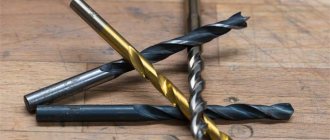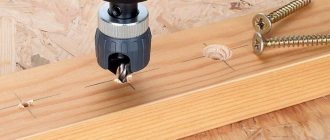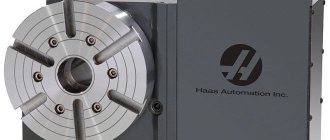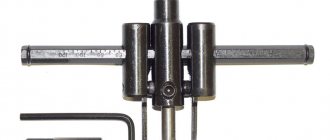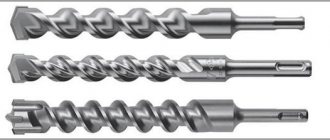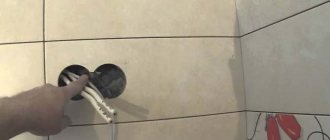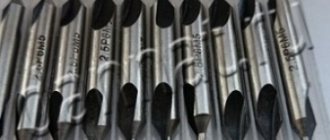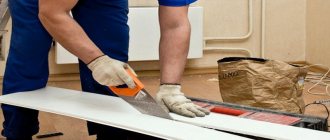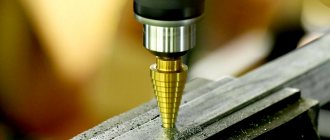Features of drilling tiles
Ceramic tiles have two qualities:
- fragility . Using the wrong tool or inappropriate drilling mode leads to chipping of the material and the appearance of chips on its surface;
- slippery surface . Most tiles are coated with a glaze that the drill glides over. Because of this, at the beginning of drilling it is necessary to use the techniques described below.
Examples of working with different types of tips
Using these videos as an example, you will clearly see how to drill tiles. The master demonstrates various nozzles in action, tells how to make holes of different diameters and shapes, from standard to figured cuts, without purchasing expensive tools.
By following the basics of working with tiles, even a beginner can make neat holes in this material.
Select end switches of the desired configuration and diameter from the list. The tile and tile drills presented in this article are designed for both the smallest holes and large ones.
Tool types
The following tools are suitable for making holes in tiles:
- hand drill . Its strengths are full control of rotation speed and lack of vibration. These advantages make a hand drill the most suitable tool for drilling ceramic tiles;
- electric drill . It is used in most cases, since hand drills are extremely rare on sale. A model with continuously adjustable chuck rotation speed is preferable: it is desirable that when drilling ceramics this parameter does not exceed 1000 rpm;
- screwdriver _ The power of this device is quite sufficient, because significant effort is not required to drill tiles. Compared to a drill, a screwdriver has an important advantage: there are models with batteries that allow you to work on sites without power supply;
- jigsaw _ Used to make large holes if there is no more suitable tool.
Will win
Sometimes ordinary pobedit drills are used instead of these tools. Provided they are sharpened well, they allow you to get good results. But it is worth considering that they will wear out in a shorter time. Pobedit is not intended for working with surfaces such as tiles and ceramics. Although such instruments are much cheaper than spear-shaped ones.
When working with such material, it is better to use these drills for ceramic tiles, even despite their rapid wear. Tools for working with porcelain tiles are much more expensive - they are bought when you need to drill a lot. If the goal is to make just a couple of holes, the most optimal option will win.
Varieties
There are several types of ceramic drills. Here is their comparative characteristics.
Spear-shaped
They have the following advantages:
- low cost: from 60 to 120 rubles;
- long service life.
These qualities make the spear-shaped drill one of the most popular when drilling holes in tiles with a diameter of up to 12 mm (the maximum for this drill).
The service life is greatly reduced when drilling porcelain stoneware - only enough for 4-5 holes. But taking into account the high cost of special drills for this material (300-500 rubles), drilling a small number of holes with two or three spear-shaped drills seems more profitable.
The profile and sharpening angle of the tool is designed exclusively for glass and ceramics. When you try to drill into brick or concrete, it quickly fails.
Pobeditovye
The winner is an alloy of tungsten and cobalt developed in the USSR, characterized by high hardness and at the same time affordable cost. Pobedite drills are quite popular as they have the optimal combination of price and durability.
Drill with pobedite tip
Carbide
A characteristic feature of this drill is the one-sided sharpening of the cutting part at an acute angle. Thanks to this, penetration into fragile materials such as ceramic tiles and natural stone occurs easily and without cracking. Carbide drills are produced with a diameter of no more than 12 mm.
Diamond coated
This variety is more suitable for professionals who need to drill tiles constantly and in large quantities, it is expensive, but:
- easily copes with even very hard materials: diamond is stronger than any other material in nature;
- has an increased resource;
- makes holes with very smooth edges, since the material is not cut, but crushed by sputtering crystals.
According to the method of fixing diamond coating, drills are divided into three types:
- with diamond chips attached to solder . This is the most affordable variety, but it loses its coating relatively quickly, especially when overheated (the solder softens);
- with mechanical fixation . Diamond chips are fused into the edge of the drill, heated by high-frequency currents to a state of plasticity. The tool is resistant to overheating and loses its coating much more easily, so it lasts longer. At the same time, its cost, although higher than the previous variety, is quite affordable;
- with laser soldering. The most expensive and durable drills. Typically used in industry.
Circular "ballerina"
The tool is similar to a compass: one “leg” is a centering drill, the second is set aside and equipped with a cutter.
There are models with two cutting “legs”. The distance between the legs, that is, the radius of the hole being made, is adjusted with a hex key.
The minimum value is 15 mm, the maximum is 45 mm. Accordingly, the “ballerina” allows you to drill holes with a diameter of 30 to 90 mm.
This type of drill is convenient if holes have to be made from time to time and of different diameters. For permanent work, it is better to purchase a set of crowns (cylindrical drills): they leave a smooth edge. After the “ballerina”, the edge of the hole has to be leveled with sandpaper or a file.
Feather
A characteristic feature of a feather drill is a pointed cone protruding in the center of the cutting edge. It allows you to accurately position the drill and at the same time “catch” on the slippery glazed surface.
There is no need to pre-core the tiles. The maximum diameter of the pen drill is 30 mm.
Universal
Manufactured from high carbon steel. They are sharpened in a special way, allowing them to process a wide range of materials.
Measures to protect the material from chips and cracks
When dealing with questions of how to drill tiles, we must not forget about precautions during work, thanks to which it will be possible to avoid deformation and complete destruction of the finishing material. First of all, to prevent the tile from cracking, it must first be soaked in plain water for 1 hour. If there is not enough time for such a solution, you can moisten the area where the holes are being drilled with a spray bottle.
To make it easier to start drilling large holes, you can cut out a stencil from fiberboard or plywood, then press it tightly against the tile to start drilling.
It is quite possible to reduce the likelihood of cracks if you step back at least 15 mm from the edge of the ceramic tile to the cutout. It’s better to calculate the installation point of the socket/shelf so that the hole for the fastening element is located on the connecting seam.
Crowns
A crown or cutter is a cylinder-shaped drill for making large-diameter holes. Base material: tool steel. At one end the cutting elements are fixed (various materials are used), at the other there is a shank for fastening in the drill chuck.
Based on their design, crowns are divided into two types:
- with centering drill: used for working with hand tools;
- without center drill: for permanent installations.
A crown without a centering drill, attached to a hand drill, “walks” on the tile when trying to drill. For drilling tiles, only sprayed cutters are used.
The toothed (carbide) varieties are designed for impact drilling and are therefore not suitable for fragile ceramics. Based on the coating material, cutters are divided into two types: diamond-coated and tungsten carbide.
The advantage of crowns is the high quality of drilling. The edge of the hole does not need to be trimmed, as after the “ballerina”.
Diamond coated
Like a diamond drill, this tool is more often used by professionals. It has a significant resource, but is expensive.
Crowns get hotter than drills, which is why diamond-coated tools are divided into two types:
- for wet drilling . Here the diamond chips are fixed in the least reliable way - on solder. When heated, it softens and the crown loses its coating. To avoid this, water must be supplied to the work area. Wet drilling cutters have an important advantage: after their service life has expired, the cutting part can be replaced, so there is no need to purchase a new crown;
- for dry cutting. Expensive crowns with coating fixed by laser soldering, immune to overheating. The tool is divided into segments by slots for effective heat dissipation. The cutting part cannot be restored; after its service life is exhausted, you have to buy a new cutter.
Tungsten carbide
The cheapest, but also the least durable variety. Typically, a tungsten carbide cutter is purchased for one-time work.
For large diameter holes
Large diameter holes required for installing sockets and conducting communications are made using crowns and circular ballerina drills.
If you need a hole with a larger diameter than the existing tool, proceed as follows:
- the contours of the opening are drawn with a marker;
- make a hole anywhere on the circle with a thin drill;
- thread a jigsaw thread into the hole. For cutting ceramics, a tungsten-coated version is used;
- fix the thread in a jigsaw and cut a hole along the contour.
Can I use a drill bit to drill into concrete?
All tile drills, except universal ones and crowns, are not designed for concrete and immediately become dull upon contact with it. Therefore, after drilling the tiles, the equipment must be replaced with a concrete drill.
Crowns drill concrete. Moreover, diamond ones, unlike tungsten carbide, also cut reinforcement. If you use a tungsten carbide crown, you should first determine the position of the reinforcement in the wall with a special detector and choose the installation location so as not to bump into it.
The segment attached to the end of the crown, onto which diamond coating is applied, is called a matrix; based on the material of the matrix, they are divided into types:
- soft (letter “M” in the marking). Designed for especially durable concrete, self-cleaning from concrete chips and dust;
- medium-hard (letter “C” in the marking). Designed for ordinary concrete with reinforcement;
- solid (letter “T” in the marking). They are used for processing high-grade concrete, drilling is carried out at low speeds.
Drilling technology
A hole in a ceramic tile is made as follows:
- switch the drill to non-impact mode and install a drill of the required diameter in the chuck. The hole in the tile should be made with a larger diameter than in concrete, otherwise when drilling concrete in the hammer drill mode, the tile may crack;
- if the tile is not yet glued, it is soaked for 40-50 minutes. (except porcelain stoneware);
- markings are applied. The location is selected so that the edge of the hole in relation to the edge of the tile is at a distance of at least 15 mm;
- carefully, avoiding significant effort, begin to drill.
Preliminary measures are taken to prevent the drill from slipping; the following techniques are used:
- scratch the glaze with the corner of a file or a hardened screw;
- stick paper tape (also known as crepe tape or masking tape) or electrical tape;
- mark with a clerical proofreader;
- drill through a jig - a block with a hole of the same diameter, pressed tightly to the tile.
Overheating of ceramics in the drilling zone leads to the appearance of cracks. To avoid this problem, the drill is periodically cooled. Having drilled through the tiles, install a concrete drill bit in the drill chuck.
The tiles that have not yet been installed are drilled in the same way as the glued ones - from the front side. The reason is that when the tool comes out of the material, chips often form.
Price
How much can you buy a drill like this for? The price, depending on the model and manufacturer, ranges from 70 to 250 rubles per unit. If you purchase a kit, the cost will be 10-15 percent lower.
By the way, drills suitable for tiles can be used to make holes in glass products. This ensures high hole cleanliness.
